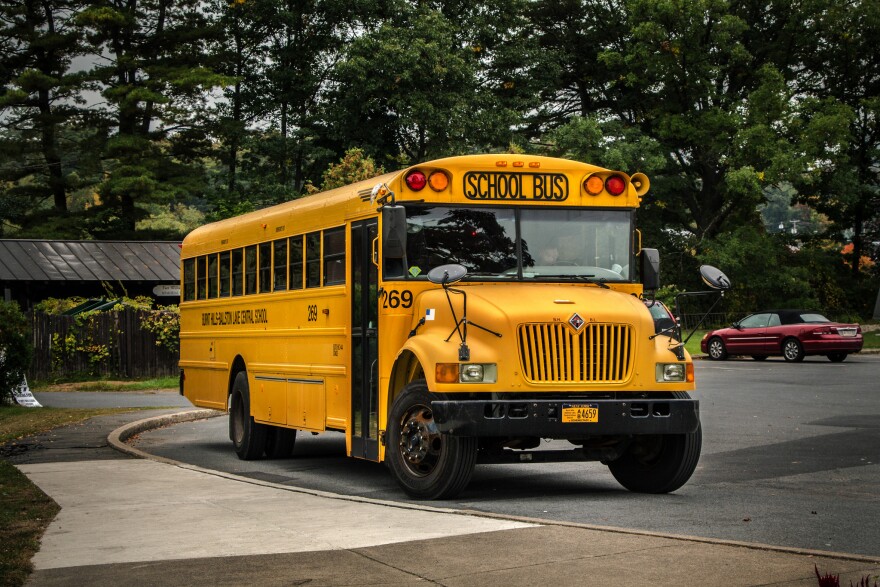Breaking up is hard to do. But in New Hampshire, multi-town school districts and administrative units (SAUs) are doing just that. Some say the process should be made easier, particularly for cooperative districts that were designed to discourage dissolution. But others warn of unintended consequences for students.
School enrollment throughout New England has been declining, a demographic change that has prompted Maine and Vermont to encourage districts and towns to combine schools and resources to save money and provide educational opportunities for students.
So, why is the trend in New Hampshire toward breaking apart?
“We are fiercely proud of local community governance. People are proud of their schools and if they can afford their own arrangement they’re looking at that,” said Ted Comstock, executive director of the New Hampshire School Boards Association, recently on The Exchange.
Carl Ladd, executive director of the NH School Administrators Association, said that can mean problems for the towns left behind.
“Marriages are inherently supposed to be difficult to break up – and I think that in the past the districts that have left have usually been more affluent, so the districts that are left with pieces and trying to fix things are the districts with fewer resources and that creates then kind of spiral of funding and personnel issues, just trying to meet the needs of students.”
BREAKING UP AND MOVING ON
Several years ago, Windham voted to withdraw from a district that included the town of Pelham. Brian Carton, chairman of the Pelham School Board, said the town is doing fine now but was left scrambling at the time.
“When you become two different districts, now you need two superintendents, you need two business administrators, two HR directors, two curriculum directors,” Carton said.
The town also needed new administrative offices, which had been located in Windham. For a time, the new superintendent worked out of a construction trailer. “ It was challenging but we did find a way to do that with practically no impact to the taxpayer. “
HOW SMALL IS TOO SMALL?
The town of Cornish recently pulled out of SAU 6, which included Cornish, Claremont, and Unity. Nicole Saginor, a Cornish school board member and head of the transition team, said Cornish decided to leave in part because the town felt it was paying too much for administrative costs associated with the large SAU building in Clarermont.
The Cornish school has just about 80 students, for grades pre-k through 8. That’s down from about 200 students years ago. “This is a very important building and center for our town so we really hope to not have to close the school,” Saginor said.
During a time when some districts are struggling with overly large classes, a small school can seem attractive.
Listener Brian from Piermont said he appreciates the individual attention his children receive in their small rural school. Still, it was startling that an additional third grader brought the grade's population to all of three students. And pre- and after-school programs are just not available.
Carl Ladd said these smaller districts and schools can find it harder to attract qualified math and science teachers, as well as art, music and physical education teachers.
“I think that sometimes when we break apart, and we go smaller and smaller and smaller, there are fewer opportunities for students to have that equitable access to a superb education because the resources become more limited,” Ladd said.
Michael from Newmarket sent in this email:
“Newmarket has had a chance to join Oyster River (Durham) and Exeter co-operative in the past but decided to stay independent. We have a crumbling 80 year old junior high/high school building in our town. Two years ago we had a vote to build a new school and it didn't pass. Now our kids have to suffer when they could have been attending one of the two best high schools in the state.”
CONSOLIDATION'S HISTORY IN NEW HAMPSHIRE
New Hampshire did at one time encourage schools to consolidate – providing building aid to cooperative districts. But that's no longer the case.
“That’s when a number of school districts joined together. And some of them were shotgun weddings. There were officials that went around the state and pushed people into joining regional school districts and coop school districts and area agreements. Some of those shotgun weddings have stood the test of time and some of them haven’t,” said Ladd.
The NH State Board of Education no longer has the authority to veto proposed breakups, Ladd said, and that's had consequences.
“So since 1996, we’ve seen a ramp up of the number of districts that have withdrawn and it’s been over the objection sometimes of the state board of education saying this could cause financial hardship for the remaining district but yet they’ve been able to withdraw anyway,” Ladd said.
SOME DIFFICULT MARRIAGES WERE WORTH SAVING
Carl Ladd was at one time chair of a district in the north country that wanted to withdraw from its SAU that includes Groveton, Stratford, and Stark.
“It was very fortunate in the long run that the state board said no, that if Groveton were to have withdrawn from SAU 58 then it would leave Stratford and Stark in a precarious financial situation and they wouldn’t be able to fund a properly adequate education. And so it forced the three districts to work together and I would say 25 years later, they have a very strong relationship, and it has overcome a lot of adversity because of it.”
Meanwhile, a committee is now looking at ways in whichto make it easier to break up cooperative districts.







